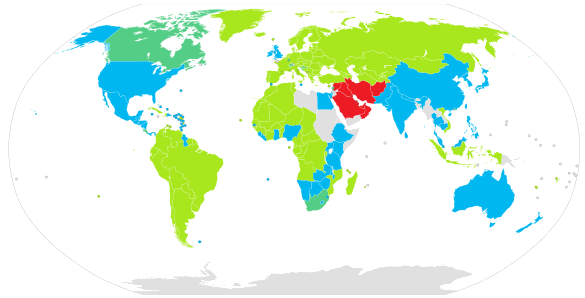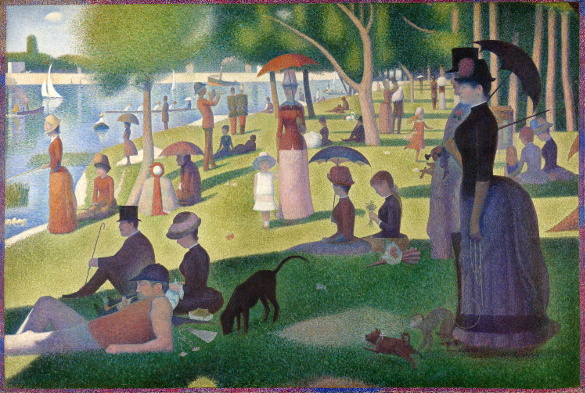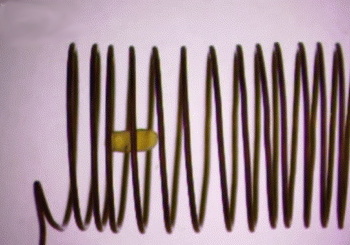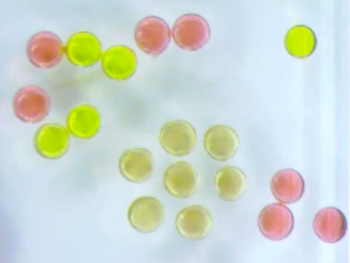Lots, and Lots, of Dots
September 9, 2019
Many
elementary school students dislike
mathematics for the simple reason that it's never ending. After mastering
integer fractions in
third grade, they need to learn about
decimal numbers in
fourth grade. They find that a
dot can be placed in a string of
numbers to separate the integer part of a
real number from its fractional part. This dot is commonly known as a
decimal point, but there are other conventions for this
decimal separator.
The decimal point is used as the decimal separator in about half the
countries in the
world, including the
United States, the
United Kingdom, the
People's Republic of China,
India,
Japan,
South Korea,
Australia, and
New Zealand. The other half uses a decimal comma instead. These comma countries include
Russia,
Germany,
Norway,
Sweden,
Denmark, and
The Netherlands (see figure). I've encountered
scientific papers and
reports that use each convention; and, while it's confusing at first, it becomes easy to
translate commas to dots as you read.

A country map of decimal separators. Decimal point countries are shown in blue, decimal comma countries are shown in green, and countries using the Arabic momayyez (similar to a forward slash) are shown in red. No data were available for the countries marked in gray. (Illustration by User:NuclearVacuum, via Wikimedia Commons
It's unfortunate that such a small symbol as a dot is used for such an important concept. Early
photocopiers were notorious for sprinkling their copies with
random debris that might be taken for decimal points in some important numbers. Modern
inkjet printers do the same in creation of their originals. A small splash of
acid on a
laboratory notebook page has the same effect. Often the only indicator is the presence or absence of a
space between numbers.
The dot is also used as the
mathematical symbol for the
dot product of
vectors. For vectors
a and
b with
magnitudes,
||a|| and
||b||, and with an
interior angle θ between them, this would be
a·b = ||a|| ||b|| cosθ. The dot is also used as a
multiplication symbol instead of
x, since numbers are vectors on the
number line with no interior angle, so the
cosine is always one.
The dot is one of the
binary characters of
Morse code, the other being the
dash. The dot indicates a short
current pulse, while a dash indicates a longer pulse. Morse code was created by by
Samuel F.B. Morse (1791-1872),
inventor of the
telegraph, and
Alfred Vail (1807-1859). Vail had the important idea of taking an
inventory of the
movable type characters at a local
newspaper to determine
letter frequency as a means of creating an
efficient code. Thus, the common letters "e" and "t" are represented by a single dot and a single dash.
Morse was also an
artist, and not long after the 1944 creation of Morse code, other artists created
oil paintings using dots of
paint instead of strokes in a technique called
pointillism. Pioneers in this technique were
Georges Seurat (1859-1891) and
Paul Signac (1863-1935). The best example of pointillism from this period is Seurat's,
A Sunday Afternoon on the Island of La Grande Jatte (Un dimanche après-midi à l'Île de la Grande Jatte), a large
oil painting of dimensions 81.7" x 121.25" that he completed in 1886 (see figure).

Georges Seurat's, A Sunday Afternoon on the Island of La Grande Jatte (Un dimanche après-midi à l'Île de la Grande Jatte).
(Located at the Art Institute of Chicago (Accession number 1926.224). Click for a larger image on Wikimedia Commons.)
Perhaps it was pointillism that inspired Leon Lenkoff of
Louisville, Kentucky, to invent his "Magic pictures" in 1980.[1] His
invention was a
coloring book containing arrays of small,
screen-printed dots of
watercolor pigment within the outline images. Application of
water with a
brush or
marker pen allowed coloring the images without the need for watercolor paints. Dots are also used in another type of
children's activity book,
connect-the-dots, that also trains number skill.
In
Linux and other
operating systems,
hidden files or directories are prefixed with a dot. People familiar with the Linux
command line interface use the
dot command for executing a
program, and many
embedded systems utilize
dot-matrix displays in which letters and numbers are formed by individual dots (see figure).
Dot distribution maps, in which the
density of dots shows the distribution of a
variable. A famous example of this is the map of the
1854 Broad Street cholera outbreak in
Soho,
Westminster, that traces the source of the
infection that
killed more than 600 people to a particular
water pump.

Company name rendered in a 5x7 dot-matrix display. Embedded system displays are typically liquid crystal displays, but today's inexpensive and highly efficient Light-emitting diodes allow creation of more readable and aesthetic displays. (Created using Inkscape.)
Astronomy has its dots, also, in the form of the
circled dot used as a
symbol for the Sun, and
Carl Sagan's iconic
photo of
Earth viewed at a distance as a
pale blue dot. The
Lewis electron dot structure was created in 1916 by
American chemist,
Gilbert N. Lewis (1875-1946), as an early explanation of the principles of
chemical bonding.
random dot stereograms were used as a tool in
visual perception.
Next to a
black hole, the
singularity of which might be considered a dot, the most important dot in today's
physics is the
quantum dot. When you shrink a
semiconductor to
nanoscale dimension, to
dot size, its
optical and
electronic properties are different from the bulk material. In particular, the optical and electronic properties of quantum dots change with size and shape, and ones with larger diameter will emit longer
wavelengths of
light, such as red, and ones with smaller diameters will emit shorter wavelengths, like blue. Such a property arises from size-dependent changes in the
electron band energies. Two principal applications of quantum dots are as
color-emitting elements in
quantum dot displays; and the
converse application, light-collecting elements in
quantum dot solar cells.
A large international team of
scientists from
Beijing University of Chemical Technology (Beijing, China),
Lawrence Berkeley National Laboratory (Berkeley, California), the
University of California, Santa Cruz (Santa Cruz, California), the
University of California, Berkeley (Berkeley, California), the
University of Massachusetts Amherst (Amherst, Massachusetts), and
Tohoku University (Sendai, Japan) has just published work on an unusual
magnetic dot. These dots are
droplets of an
aqueous dispersion of
magnetite (Fe3O4) nanoparticles formed by
jet printing into
oil, and they exhibit
ferromagnetism, so they can be manipulated magnetically.[2-5]
When people think of
magnets, they are thinking of
ferromagnets, which are
materials like
iron that are attracted to a
magnet or can be made into a magnet. Permanent magnetism arises when
electron spins in the solid are locked into alignment by strong spin-spin
interaction below a critical
temperature called the
Curie temperature. Another type of magnet is a
paramagnet, a type of material that's attracted to a permanent magnet but can't be permanently magnetized. An example of this type of magnet is
iron (II) oxide (ferrous oxide). Paramagnets have a weaker coupling between electron spins, so exposure to a magnetic field does not render them permanent magnets.
Ferrofluids are are
colloid of nanoscale magnetic particles in a carrier fluid such as water or oil. To inhibit
clumping, the particles are coated with a
surfactant. While ferrofluids are attracted to a magnet, they are not ferromagnets and they can not be permanently magnetized.
Mechanical engineers are more likely that other scientists and
engineerss to have used ferrofluids, since they are used in
rotary seals as
ferrofluidic seals.[6] The aforementioned research team has discovered a way to couple the magnetic moments of superparamagnetic ferrofluidic nanoparticles of
magnetite in a colloid to make a fluid magnet.[2]
Says research team leader,
Tom Russell, a
professor of
polymer science and engineering at the University of Massachusetts, Amherst,
"We wondered, If a ferrofluid can become temporarily magnetic, what could we do to make it permanently magnetic, and behave like a solid magnet but still look and feel like a liquid?... We've made a new material that is both liquid and magnetic. No one has ever observed this before... This opens the door to a new area of science in magnetic soft matter."[4]

A magnetic droplet of magnetite (Fe3O4) nanoparticles propelled through a solenoid coil.
(Xubo Liu et al./Berkeley Lab image. Click for animated image.)
The researchers used a
3D-printing technique to print 1 mm droplets from a ferrofluid solution containing 20
nanometer magnetite nanoparticles.[4] They found that the nanoparticles formed a solid-like shell at the water-oil liquid-liquid
interface, a
phenomenon known as
interfacial jamming, that produced a
reversible paramagnetic-to-ferromagnetic
transformation.[2,4] The droplets were magnetized by a
solenoid coil, and their magnetic attraction caused them to clump together.[4] The 8 nanometer gap between nanoparticles at the jammed surface allowed magnetic alignment of the particles, and it was found that even smaller droplets than these, with diameters about the
size of a human hair (about 75
micrometers), were also magnetic.[4]
Unlike solid magnets, these liquid can be reconfigured into different shapes while preserving their magnetic properties, including
north-south dipole interactions.[2] Like permanent magnets, the ferromagnetic liquid droplets exhibit the properties of
coercivity and
remanence, and they're easy to control with external magnetic fields.[2] All the north-south poles in droplet arrays respond in unison, just as would the individual
magnetic domains of solid ferromagnet.[4] The droplets can also be demagnetized.[4]

An array of magnetic droplet, 1 millimeter in diameter, with different magnetic character. The green droplets are paramagnetic without any jammed nanoparticles at the liquid interface, the red droplets are paramagnetic with nonmagnetic nanoparticles jammed at the interface, and the brown droplets are ferromagnetic with magnetic nanoparticles jammed at the interface.
(Xubo Liu et al./Berkeley Lab image.)
The small size of the droplets, combined with their unusual magnetic properties, suggest applications that range from artificial
cells that deliver
cancer therapies, to shape-changing
flexible robots that adapt to their
liquid environment.[4] Miniature robots can be devised to seek out
diseased cells.[4] Says
Xubo Liu, the study’s lead author who as a
postdoctoral student discovered the droplets magnetism when he saw their movement on a
magnetic stir plate, "What began as a
curious observation ended up opening a new area of science... It's something all young researchers dream of, and I was lucky to have the chance... to make it a reality."[4]
References:
- Leon G. Lenkoff, "Magic pictures," US Patent No. 4,212,393, July 15, 1980.
- Xubo Liu, Noah Kent, Alejandro Ceballos, Robert Streubel, Yufeng Jiang, Yu Chai, Paul Y. Kim, Joe Forth, Frances Hellman, Shaowei Shi, Dong Wang, Brett A. Helms, Paul D. Ashby, Peter Fischer, and Thomas P. Russell, "Reconfigurable ferromagnetic liquid droplets," Science, vol. 365, no. 6450 (July 19, 2019), pp. 264-267, DOI: 10.1126/science.aaw8719.
- Rémi Dreyfus, "An attractive, reshapable material," Science, vol. 365, no. 6450 (July 19, 2019), p. 219, DOI: 10.1126/science.aax8979.
- Theresa Duque, "New Laws of Attraction: Scientists Print Magnetic Liquid Droplets," Lawrence Berkeley National Laboratory Press Release No. 510-495-2418, July 18, 2019.
- Scientists Print Liquid Magnetic Droplets, Berkeley Laboratory YouTube Video by Marilyn Chung/Berkeley Lab, July 19, 2019 .
- Ronald E Rosensweig, "Magnetic fluid seals," US Patent No. 3,620,584, November 16, 1971.
Linked Keywords: Elementary school; student; mathematics; integer; fraction (mathematics); third grade; decimal number; fourth grade; decimal separator; dot; number; real number; decimal point; country; countries; world; United States; United Kingdom; People's Republic of China; India; Japan; South Korea; Australia; New Zealand; Russia; Germany; Norway; Sweden; Denmark; The Netherlands; scientific literature; scientific paper; report; translation; translate; Arabic; momayyez; forward slash; data; User:NuclearVacuum; Wikimedia Commons; photocopier; randomness; random; debris; inkjet printing; inkjet printer; acid; laboratory notebook; space (punctuation); mathematical symbol; dot product; Euclidean vector; magnitude; interior angle; multiplication; number line; cosine; binary code; sign (semiotics); character; Morse code; dash; electric current; pulse (physics); Samuel F.B. Morse (1791-1872); invention; inventor; electrical telegraph; Alfred Vail (1807-1859); inventory; movable type; newspaper; letter frequency; efficiency; efficient; artist; oil painting; paint; pointillism; Georges Seurat (1859-1891); Paul Signac (1863-1935); A Sunday Afternoon on the Island of La Grande Jatte (Un dimanche après-midi à l'Île de la Grande Jatte); Louisville, Kentucky; coloring book; screen printing; screen-printed; watercolor painting; pigment; water; brush; marker pen; children's activity book; connect-the-dots; Linux; operating system; hidden files or directories; command line interface; dot command; computer programming; program; embedded system; dot-matrix displays; Dot distribution map; area density; variable; 1854 Broad Street cholera outbreak; Soho; City of Westminster; infection; death; kill; water pump; Company; trade name; liquid crystal display; energy conversion efficiency; highly efficient; light-emitting diode; aesthetic; Inkscape; astronomy; circled dot; Solar symbol; symbol for the Sun; Carl Sagan; photograph; Earth; pale blue dot; Lewis electron dot structure; American; chemist; Gilbert N. Lewis (1875-1946); chemical bond; chemical bonding; random dot stereogram; visual perception; black hole; gravitational singularity; physics; quantum dot; semiconductor; nanoscopic scale; nanoscale dimension; optics; optical; electronic; wavelengths; light; electronic band structure; electron band energy; electromagnetic spectrum; color-emission; quantum dot display; converse (logic); quantum dot solar cell; scientist; Beijing University of Chemical Technology (Beijing, China); Lawrence Berkeley National Laboratory (Berkeley, California); University of California, Santa Cruz (Santa Cruz, California); University of California, Berkeley (Berkeley, California); University of Massachusetts Amherst (Amherst, Massachusetts); Tohoku University (Sendai, Japan); magnetic field; magnetic; drop (liquid); droplet; aqueous solution; dispersion (chemistry); magnetite (Fe3O4); nanoparticle; jet printing; oil; ferromagnetism; magnet; ferromagnet; material; iron; electron magnetic moment; electron spin; interaction; temperature; Curie temperature; paramagnetism; paramagnet; iron (II) oxide (ferrous oxide); Ferrofluid; colloid; clumping; surfactant; mechanical engineering; Mechanical engineer; engineer; radial shaft seal; rotary seal; ferrofluidic seal; Tom Russell; professor; polymer science and engineering at the University of Massachusetts, Amherst; soft matter; solenoid coil; 3D-printing; nanometer; interface (chemistry); phenomenon; jamming (physics); interfacial jamming; reversible process (thermodynamics); reversible; phase transition; transformation; solenoid coil; hair's breadth; size of a human hair; micrometer; magnetic dipole; north-south dipole; coercivity; remanence; magnetic domain; millimeter; diameter; cell (biology); cancer; chemotherapy; deflection (engineering); flexible; robot; liquid; environment; disease; Xubo Liu; postdoctoral student; magnetic stirrer; magnetic stir plate; serendipity; curious observation; Leon G. Lenkoff, "Magic pictures," US Patent No. 4,212,393, July 15, 1980.